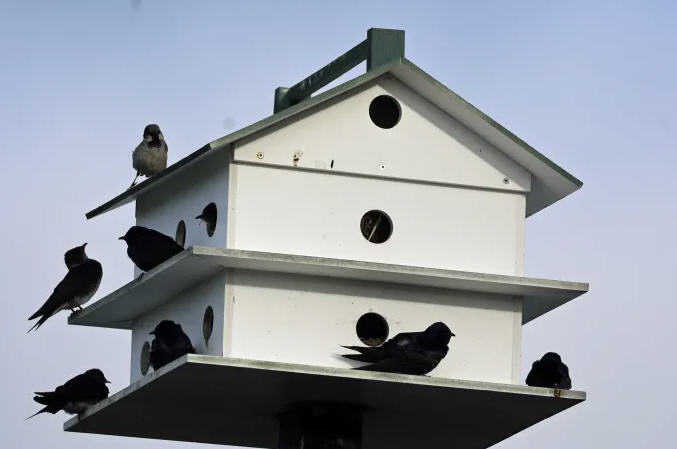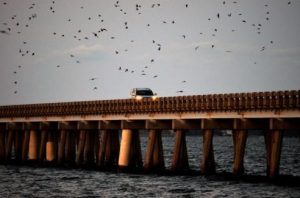
From early spring into late summer, a small, dark, pointed winged bird can be seen darting to and fro in search of its sustenance — flying insects. They are Purple Martins (Progne subis), and they have an amazing history of co-existence with people dating back centuries. They are present because of several condo-like nesting houses in the village.
They are easily seen all around Ocracoke Village, especially the Silver Lake Harbor and Oyster Creek and along the South Point Road is another good location. They are often joined by another insect eater, Barn Swallows (Hirundo rustica), a related species.
Purple Martins are secondary cavity nesters. That is, they do not excavate their own cavities like woodpeckers. Instead, in the past they used already created cavities by other animals or natural cavities found in dead trees or cliff rock formations. Except for a subspecies in the northwest region of the United States, Purple Martins are one of only three species that no longer nest in natural cavities and now use human-assisted habitats. The others are Barn Swallows and Chimney Swifts.
The first commercial manufacturer of Purple Martin houses, many highly ornate, was launched in 1883 and by the early 1900s, the birds relied almost exclusively on man-made housing.
This nesting shift may have begun centuries ago with Native Americans using hollowed-out gourds to encourage their presence.
Mark Catesby, an English naturalist and gifted artist, is credited with the first published accounts of the flora and fauna of North America.
In his “Natural History of Carolina, Florida and the Bahama Islands,” a series of volumes published between 1729 and 1747, he wrote, “These martins breed like Pigeons in lockers prepared for them against houses, and in gourds hung on poles for them to build in, they being of great use about houses and yards, for pursuing and chasing away Crows, Hawks, and other vermin from the Poultry. They retire at the approach of Winter and return in the Spring to Virginia and Carolina.”
Ornithologist Alexander Wilson reported in 1808 seeing Chickasaws and Choctaws having hanging gourds for martins on stripped saplings near their cabins and African Americans were doing likewise on long canes on the banks of the Mississippi.
As for their reputation for being voracious mosquito eaters, well not so much.
In the 1960s, a manufacturer of Purple Martin birdhouses, J.L. Wade, claimed they ate 2,000 mosquitoes a day.
This has been proven false, but their reputation as mosquito eaters persists.
Mosquitoes are too small for them to be bothered with and do not inhabit the high aerial levels where they feed. Their diet consists exclusively of a wide variety of larger-flying insects caught on the wing, including dragonflies, grasshoppers, beetles, flies, wasps and bees.
Despite Wade’s erroneous and self-serving assertion, he should not be dismissed as a purveyor of misinformation for profit. He has been the greatest proponent of establishing Purple Martin colonies throughout the country with great success.
There are plenty of options for choosing Purple Martin nesting sites. Being colonial nesters, birdhouses should have several compartments, typically eight to 12, on a pole 10 feet or higher sunk deep into the ground to withstand severe weather.
Inside their units, they will build a nest and then lay up to eight eggs.
Only the female, who has a brood patch, a featherless area rich in blood vessels that transfers heat to the eggs, does the incubation which takes place approximately in 15 to 18 days.
Because they use human-assisted habitat, they also need human intervention and management of the colony sites.
The most important feature is to be able to raise and lower the housing and open the cavities for cleaning, maintenance and removing the nesting materials after they depart. Other recommendations are a predator guard to keep raccoons and snakes from climbing the pole and entrance holes with starling-resistant shapes.
A major challenge is to keep European Starlings and House Sparrows from using them. Because these two introduced species are year-round residents, they have the advantage of getting first housing dibs. One way to control their use is by blocking the entrance holes after fledging until their anticipated return in early spring. It is quite common for Purple Martins and House Sparrows to share a multi-unit bird house.
The Purple Martin Conservation Society has a lot of information on choosing and maintaining housing.
If you can spend some time near one of the nesting sites, you will find they are fun to watch.
These are true acrobats, speedy with rapid, flapping, and gliding flight patterns. When approaching their nesting site, they can dive from the sky at great speeds.
Highly vocal, they have a variety of chattering sounds. Some people erecting a bird house for the first time have had some success by playing sound recordings of them in hopes of attracting those migrating in the spring.
 With a wingspan up to 15 inches and weighing all of two ounces, Purple Martins are the world’s largest amongst the 90-odd swallow and martin species in the family Hirundinidae.
With a wingspan up to 15 inches and weighing all of two ounces, Purple Martins are the world’s largest amongst the 90-odd swallow and martin species in the family Hirundinidae.
They get their color name from the adult males that are entirely dark with a glossy bluish sheen. Martin derives from the Old French “martinet,” which referred to a type of swift or swallow. Adult females are dark on top with some steel blue sheen and pale underparts. They have a short forked tail, quite different from the long tail feathers of the Barn Swallow which also nests on Ocracoke.
In late summer, after leaving the nesting colony, in preparation for the long migration mostly to the Amazon Basin, Purple Martins will gather in large flocks and temporarily establish communal evening roost sites.
One such site is the Old Manns Harbor William B. Umstead bridge, part of U.S. 64. It spans the Croatan Sound between Roanoke Island and the Dare County mainland. It is currently closed and will be for several months while it undergoes extensive restorations. For years The birds have roosted under the bridge at night, leave at sunrise to fly over the coastal plain to feed during the day, then return at sunset.
In the past, beginning in late July, there have been estimates of more than 100,000 birds but those numbers have diminished significantly in the last couple of years, possibly due to their finding another similar bridge to roost.
So, yes. Thanks to the efforts of some island “landlords,” Purple Martins have found affordable housing on Ocracoke, even sharing their condo-style birdhouse with those pesky House Sparrows.


